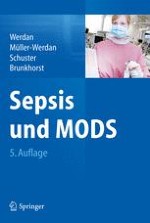Zusammenfassung
Derzeit erkranken in Deutschland ca. 180.000 Patienten jährlich an septischen Infektionen. Die Prävalenz auf deutschen Intensivstationen liegt bei 12,4% (Sepsis) bzw. bei 11,0% (schwere Sepsis und septischer Schock). Die Inzidenz liegt bei 106/100.000 Einwohner (Sepsis), 84/100.000 Einwohner (schwere Sepsis) und 23/100.000 Einwohner (septischer Schock). Im Jahr 2011 betrugen die Krankenhaussterblichkeitsraten 10,5% für die Sepsis, 42,8% für die schwere Sepsis und 60,5% für den septischen Schock.











